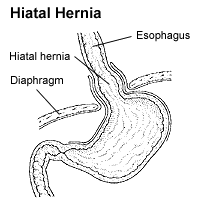
Photo from wikipedia
OBJECTIVE To evaluate the decision of watchful waiting (WW) versus elective laparoscopic hernia repair (ELHR) for minimally symptomatic paraesophageal hernias (PEH) with respect to cost-effectiveness. BACKGROUND The current recommendation for… Click to show full abstract
OBJECTIVE To evaluate the decision of watchful waiting (WW) versus elective laparoscopic hernia repair (ELHR) for minimally symptomatic paraesophageal hernias (PEH) with respect to cost-effectiveness. BACKGROUND The current recommendation for minimally symptomatic PEHs is watchful waiting. This standard is based on a decision analysis from 2002 that compared the two strategies on quality-adjusted life-years (QALYs). Since that time, the safety of ELHR has improved. A cost-effectiveness study for PEH repair has not been reported. METHODS A Markov decision model was developed to compare the strategies of WW and ELHR for minimally symptomatic PEH. Input variables were estimated from published studies. Cost data was obtained from Medicare. Outcomes for the two strategies were cost and QALY's. RESULTS ELHR was superior to the WW strategy in terms of quality of life, but it was more costly. The average cost for a patient in the ELHR arm was 11,771 dollars while for the WW arm it was 2207. CONCLUSION This study shows that WW and ELHR both have benefits in the management of minimally symptomatic paraesophageal hernias.
Journal Title: American journal of surgery
Year Published: 2018
Link to full text (if available)
Share on Social Media: Sign Up to like & get
recommendations!